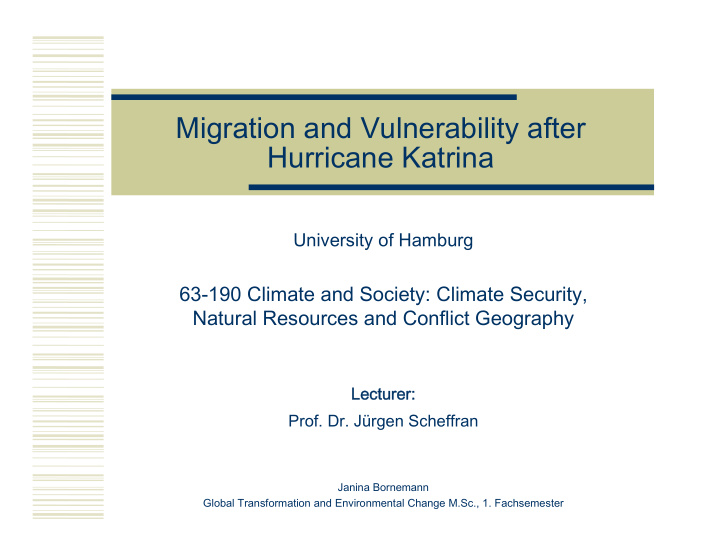



Migration and Vulnerability after Hurricane Katrina University of Hamburg 63-190 Climate and Society: Climate Security, Natural Resources and Conflict Geography Lecturer: Prof. Dr. Jürgen Scheffran Janina Bornemann Global Transformation and Environmental Change M.Sc., 1. Fachsemester
Structure Hurricane Katrina in New Orleans Forms of migration after Hurricane Katrina Vulnerability after Hurricane Katrina „The City that care forgot“ Conclusion
Hurricane Katrina Stroke the gulf coast on 29 th of August 2005 Biggest migration movement since the dust bowl in the 1930s Economic damage of more that 125 Billion US Dollar 80 per cent of New Orleans was flooded More than one million people in the metropolitan area of New Orleans flew from Hurricane Katrina
Path of Hurricane Katrina
Elevation profile of New Orleans
Forms of migration spillover -migration permanent migration or return migration?
spillover -migration
Vulnerabiliy • „Social vulnerability is a product of social inequalities— social factors and forces that create the susceptibility of various groups to harm, and in turn affect their ability to respond, and bounce back (resilience) after the disaster.“ (Cutter 2006) The most vulnerable people of New Orleans were hit hardest People with lower socioeconomic status African-American People without cars Very old or sick people Families with many children
Vulnerability • People with lower socio-economic status Are mory likely to live below the poverty line Are less likely to own cars Are more likely to live for rent Often live in flood-prone areas of New Orleans Rarely can bear the costs for a return migration Are often less well educated and are therefore less informed about assistance programs in New Orleans
Vulnerability African Americans are more likely to have a lower socioeconomic status, to be tenants, to have larger families and to not own a car than people of white skin color = Characteristics that make them more vulnerable to disasters like Hurricane Katrina
„The City that care forgot“ • The Flood protection system in New Orleans was not maintained for decades • The Federal Emergency Management Agency (FEMA) was not sufficiently equipped for evacuation • At the day of the storm all bus and train connections were cancelled
Conclusion • The flood of the city after the Hurricane was caused largely antropogenic • The socio-economic status of a person has a large influence on the migration probability and the vulnerability after Hurricane Katrina
Discussion „More recently, the poor wihout private transport, elderly and disabled, in New Orleans were abandoned by officials and could not flee the city ahead of hurricane Katrina. Their only option was the sordid conditions of the Superdome as shelter. Over a thousand died. But can we call these deaths „natural“ - the unavoidable confrontation of human beings with the fury of nature?“ (Wisner 2008)
Thanks for your attention!
Literature Bates, Diane C. (2002): Environmental Refugees? Classifying Human Migrations Caused by Environmental Change. In: Population and Environment , 23 (5), 465-477. Text abrufbar unter: http://www.jstor.org/stable/27503806 (Zugriff am: 21.12.2010). Cutter, Susan L./Boruff, Bryan J./Shirley, W. Lynn (2003): Social Vulnerability to Environmental Hazards. In: Social Science Quarterly, 84 (2), 242-261. Text abrufbar unter: http://www.colorado.edu/hazards/resources/socy4037/Cutter%20%20%20Social%20vulnerability%20to%20en vironmental%20hazards.pdf (Zugriff am 29.12.2010). Cutter, Susan (2006): The Geography of Social Vulnerability: Race, Class, and Catastrophe. Text abrufbar unter: http://understandingkatrina.ssrc.org/Cutter/ (Zugriff am 29.12.2010). Elliott, James R./Pais, Jeremy (2006) Race, class, and Hurricane Katrina: Social differences in human responses to disaster. In: Social Science Research, 35 (2), 295-321. Text abrufbar unter: http://www.tulane.edu/~jre/Elliott_Pais_2006_SSR.pdf (Zugriff 27.12.2010). FAZ (03.09.2005): “Jetzt kehrt die Zuversicht in unsere Herzen zurück”. Text abrufbar unter: http://www.faz.net/s/RubB08CD9E6B08746679EDCF370F87A4512/Doc~EC71D375077094AD6B3B9166AEC EFFF0D~ATpl~Ecommon~Sspezial.html (Zugriff am 26.12.2010).
Literature Frey, William H./Singer, Audrey (2006): Katrina and Rita Impacts on Gulf Coast Populations: First Census Findings. The Brookings Institution: Metropolitan Policy Program. Text abrufbar unter: http://www.brookings.edu/metro/pubs/20060607_hurricanes.pdf (Zugriff am 11.12.2010). Gabe, Thomas/Falk, Gene/McCarty, Maggie/Mason, Virginia W. (2005): Hurricane Katrina: Social-Demographic Characteristics of Impacted Areas. CRS Report for Congress. Text abrufbar unter: http://gnocdc.s3.amazonaws.com/reports/crsrept.pdf (Zugriff am 11.12.2010). Groen, Jeffrey A./Polivka, Anne E. (2009): Going Home after Hurricane Katrina: Determinants of Return Migration and Changes in Affected Areas. U.S. Bureau of Labor Statistics. Working Paper 428. Text abrufbar unter: http://www.bls.gov/ore/pdf/ec090060.pdf (Zugriff am 18.12.2010). Höppe, Peter/Loster, Thomas (2007): Klimawandel und Wetterkatastrophen. In: Geographische Rundschau, 59 (10). 26-31. Jacob, Christian/Schorb, Friedrich (2008): Soziale Säuberung. Wie New Orleans nach der Flut seine Unterschicht vertrieb. Müster: UNRAST. Kendall, Diana (2010): Social Problems in a diverse society, 5th Edition. Boston: Pearson.
Literature Knabb, Richard D./Rhome, Jamie R./Brown, Daniel P. (2005): Tropical Cyclone Report: Hurricane Katrina. Text abrufbar unter: http://www.nhc.noaa.gov/pdf/TCR-AL122005_Katrina.pdf (Zugriff am 31.12.2010). Nigg, Joanne M. /Barnshaw, John/Torres, Manuel R. (2006): Hurricane Katrina and the Flooding of New Orleans: Emergent Issues in Sheltering and Temporary Housing. In: Annals of the American Academy of Political and Social Science , 604, Shelter from the Storm: Repairing the National Emergency Management System after Hurricane Katrina, 113-128. Text abrufbar unter: http://www.jstor.org/stable/25097784 (Zugriff am: 05.12.2010). Nunn, Kenneth B. (2009): Still Up on the Roof. Race, Victimology, and Response to Hurricane Katrina. In: Levitt, Jeremy I./Whitaker, Matthew C. (Hrsg.), Hurricane Katrina. America's unnatural disaster. Lincoln/London: University of Nebraska Press, 183 - 205. Pais, Jeremy F./Elliott, James R. (2008): Places as Recovery Machines: Vulnerability and Neighborhood Change After Major Hurricanes. In: Social Forces 86 (4), 1315-1453. Text abrufbar unter: http://130.102.44.247/journals/social_forces/v086/86.4.pais.pdf (Zugriff am 14.12.2010). Sanyika, Mtangulizi (2009): Katrina and the Conditions of Black New Orleans. The Struggle to Justice, Equity and Democracy. In: Bullard, Robert D./Wright, Beverly (Hrsg.), Race, Place and Enrivonmental Justice after Hurricane Katrina. Struggles to Reclaim, Rebuilt, and Revitalize New Orleans and the Gulf Coast. Boulder: Westview Press, 87 – 111. Wisner, Ben/Blaikie, Piers/Cannon, Terry/Davis, Ian (2004): At Risk. Second Edition. Natural hazards, people's vulnerability and disasters. London/New York: Routledge. Wisner, Ben (2008): How natural are „Natural“ Disasters. In: Kulke, Elmar/Popp, Herbert (Hrsg.). Umgang mit Risiken. Katastrophen – Destabilisierung – Sicherheit. Deutsche Gesellschaft für Geographie: Bonn. 99-113.
Recommend
More recommend